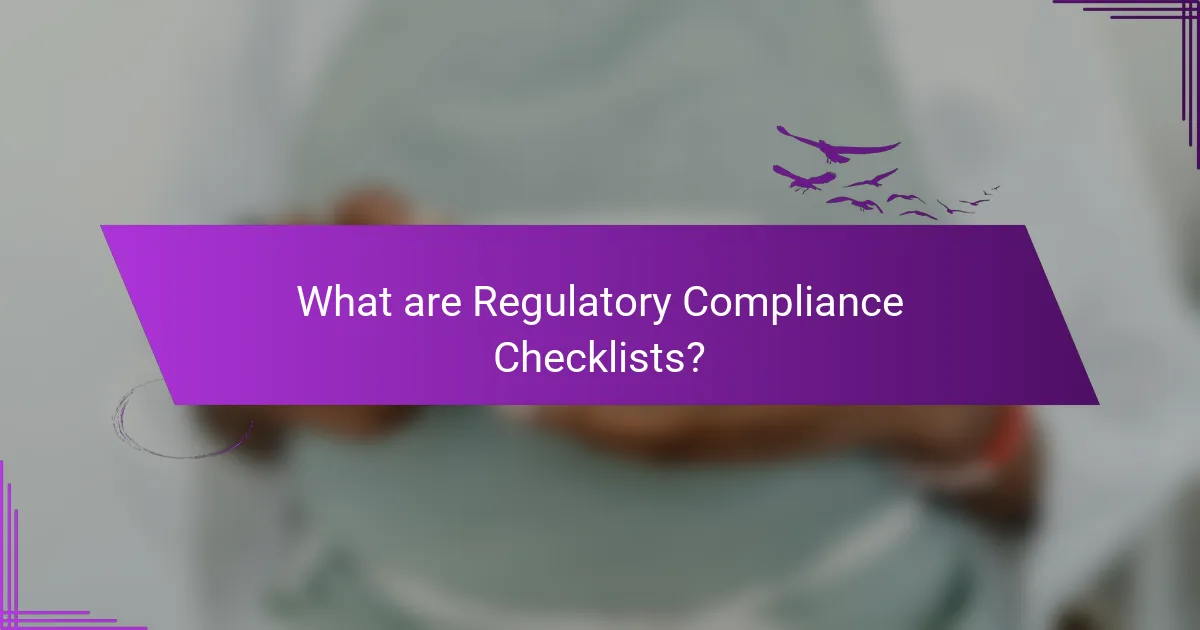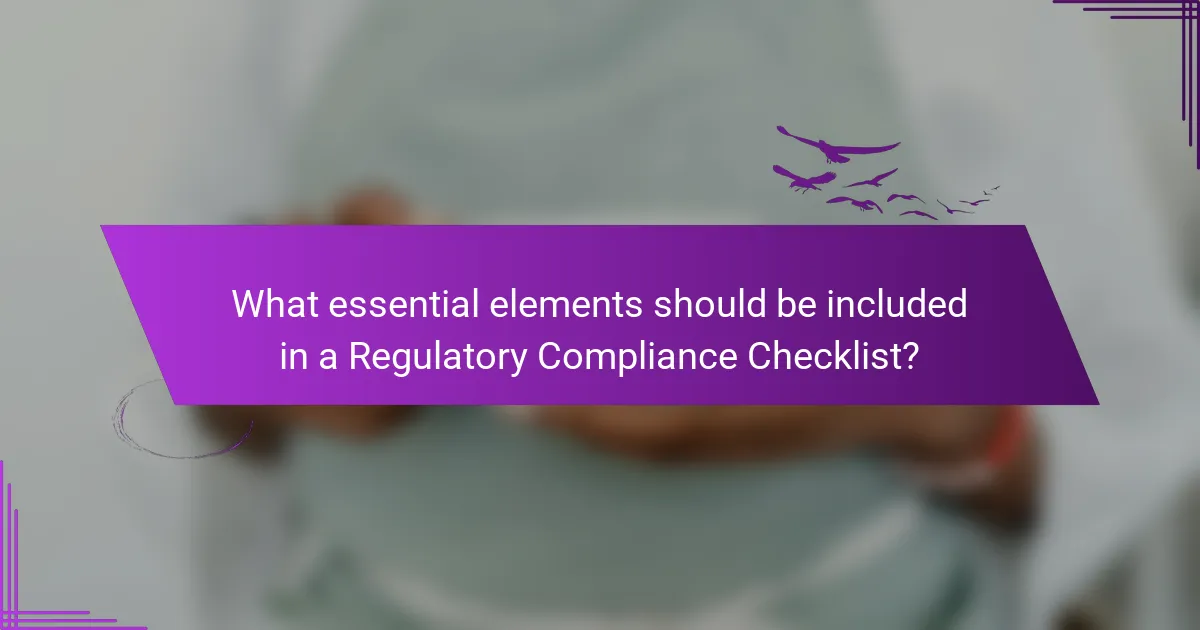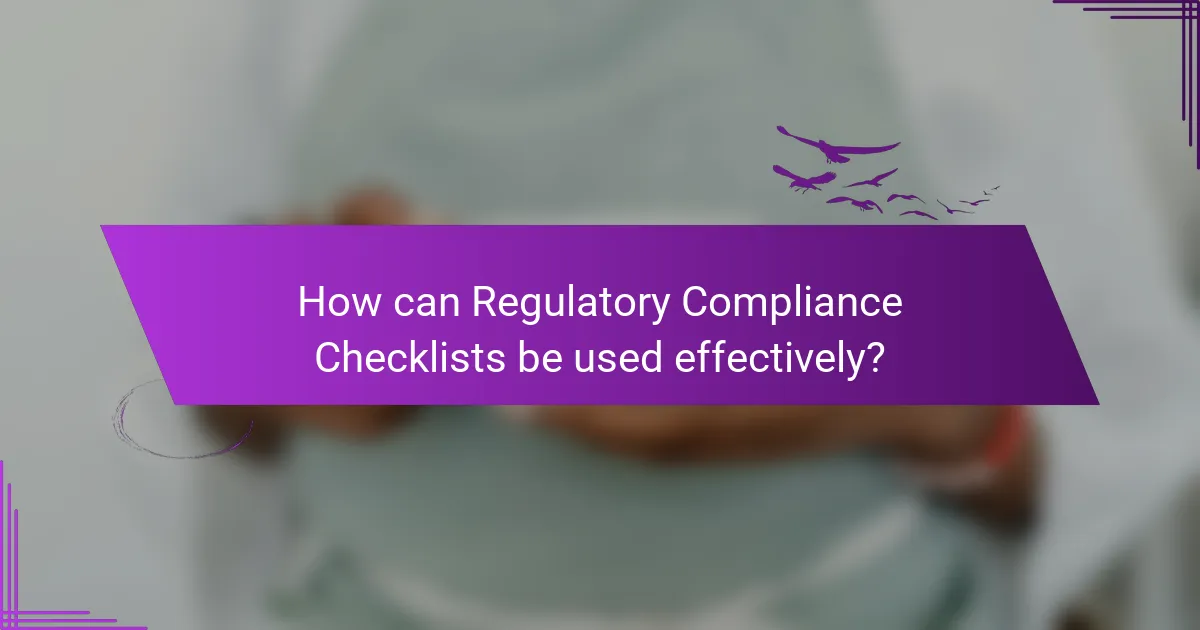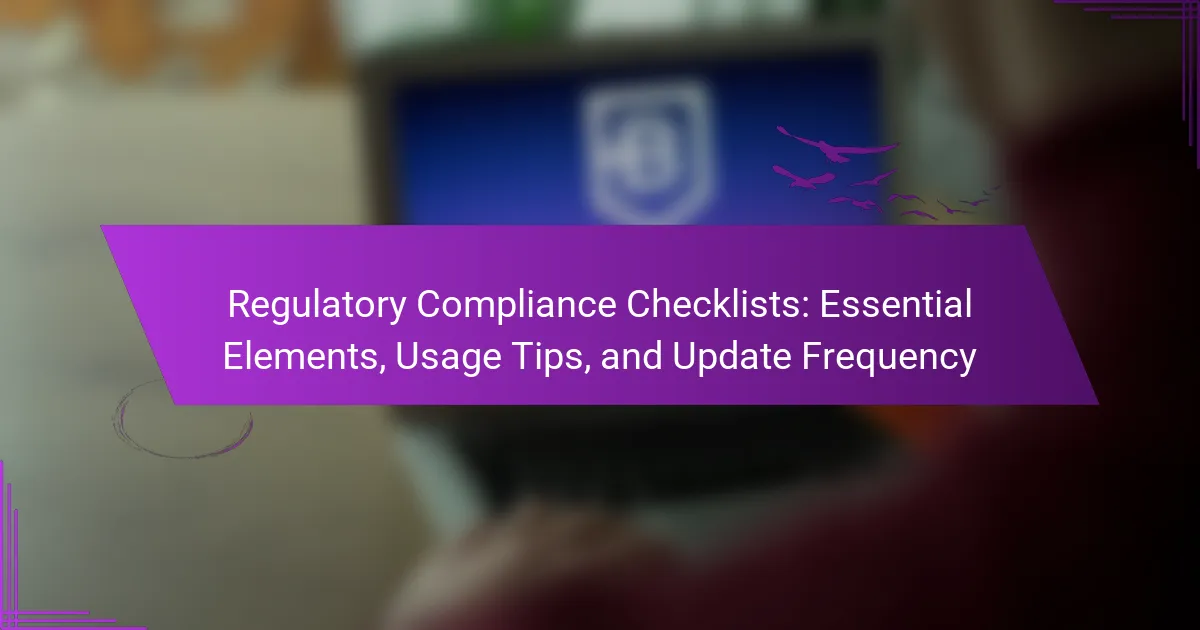
What are Regulatory Compliance Checklists?
Regulatory compliance checklists are structured tools used to ensure adherence to laws and regulations. They provide a systematic way to verify compliance with specific legal requirements. Organizations utilize these checklists to identify necessary actions and document compliance efforts. Each checklist typically includes relevant regulations, required documentation, and deadlines. The use of checklists enhances accountability and minimizes the risk of non-compliance. They are essential for audits and regulatory reviews. Many industries, such as finance and healthcare, rely on these tools for effective compliance management.
How do Regulatory Compliance Checklists function?
Regulatory compliance checklists function as structured tools to ensure adherence to laws and regulations. They provide a systematic way to identify and evaluate compliance requirements. Each checklist item corresponds to specific regulations or standards. Users can mark items as completed or pending. This process helps organizations track compliance status effectively. Checklists facilitate audits by providing documented evidence of compliance efforts. They can be customized to fit specific industries or regulatory environments. Regular updates ensure that the checklist remains relevant to changing regulations.
What key components are included in a Regulatory Compliance Checklist?
A Regulatory Compliance Checklist typically includes several key components. These components are essential for ensuring adherence to regulations. Common elements are regulatory requirements, applicable laws, and internal policies.
Regulatory requirements outline the specific obligations that must be met. Applicable laws refer to the legal standards relevant to the organization. Internal policies provide guidelines for compliance within the organization.
Additionally, the checklist may include deadlines for compliance, responsible parties for each requirement, and documentation needed for verification. Regular updates to the checklist ensure that it reflects any changes in regulations.
These components collectively help organizations maintain compliance and avoid penalties.
How do these components contribute to compliance efforts?
The components of regulatory compliance checklists enhance compliance efforts by providing clear guidelines. They outline specific requirements that organizations must meet. This clarity reduces ambiguity in regulatory expectations. Checklists facilitate systematic tracking of compliance activities. They serve as a reference point for audits and assessments. Regular updates to these components ensure alignment with changing regulations. This adaptability helps organizations avoid penalties and maintain operational integrity. Evidence shows that structured compliance approaches improve adherence rates significantly.
Why are Regulatory Compliance Checklists important?
Regulatory compliance checklists are important because they ensure organizations adhere to legal and industry standards. These checklists help identify regulatory requirements specific to an organization. They promote consistency in compliance efforts across departments. Checklists also facilitate training and awareness among employees regarding compliance obligations. Furthermore, they reduce the risk of non-compliance, which can lead to fines and legal issues. According to a study by the Compliance, Governance and Oversight Council, organizations using checklists improve compliance adherence by up to 30%. This demonstrates the effectiveness of checklists in managing compliance risks.
What risks do organizations face without Compliance Checklists?
Organizations face significant risks without compliance checklists. These risks include legal penalties due to non-compliance with regulations. A lack of checklists increases the likelihood of oversight in critical compliance areas. This can lead to financial losses from fines or lawsuits. Additionally, organizations may suffer reputational damage if they fail to meet industry standards. Inefficiencies in operations can arise from unclear compliance processes. Without checklists, employee training on compliance may be inadequate. This can result in increased errors and violations. Ultimately, the absence of compliance checklists jeopardizes organizational integrity and trust.
How do Compliance Checklists improve operational efficiency?
Compliance checklists improve operational efficiency by standardizing processes and ensuring adherence to regulations. They provide a clear framework for tasks, reducing ambiguity in operations. This clarity minimizes errors and enhances productivity. By following a checklist, teams can streamline workflows and prioritize essential tasks. Compliance checklists also facilitate training for new employees, enabling quicker onboarding. Furthermore, they promote accountability by assigning specific responsibilities. Regular use of checklists can lead to continuous improvement in operational practices. According to a study by the American Society for Quality, organizations using checklists experienced a 30% increase in process efficiency.

What essential elements should be included in a Regulatory Compliance Checklist?
A Regulatory Compliance Checklist should include the following essential elements: applicable regulations, compliance requirements, documentation procedures, deadlines, responsible personnel, monitoring processes, and review dates. Applicable regulations outline the specific laws and standards relevant to the organization. Compliance requirements detail the actions needed to meet those regulations. Documentation procedures specify how compliance efforts will be recorded and maintained. Deadlines indicate when compliance actions must be completed. Responsible personnel are designated individuals accountable for compliance tasks. Monitoring processes involve regular checks to ensure ongoing adherence. Review dates are scheduled times to reassess compliance status and update the checklist as needed.
What categories of compliance should be addressed?
Categories of compliance that should be addressed include legal compliance, regulatory compliance, and internal compliance. Legal compliance pertains to adhering to laws and regulations applicable to a business. Regulatory compliance involves following specific industry regulations set by governing bodies. Internal compliance focuses on an organization’s policies and procedures. Each category is crucial for maintaining operational integrity and avoiding legal penalties. Compliance frameworks often require regular audits to ensure adherence. These categories collectively support a comprehensive compliance strategy.
How can organizations determine relevant compliance categories?
Organizations can determine relevant compliance categories by conducting a thorough assessment of applicable laws and regulations. This involves identifying the specific industry standards that govern their operations. Organizations should also analyze their business activities to pinpoint compliance requirements linked to those activities. Engaging with legal experts can provide clarity on complex regulatory landscapes. Additionally, organizations can utilize compliance management software to streamline the identification of relevant categories. Regularly reviewing changes in regulations ensures that organizations stay updated with compliance requirements. These methods are supported by industry best practices and guidelines from regulatory bodies.
What examples of industry-specific compliance categories exist?
Examples of industry-specific compliance categories include healthcare, finance, and manufacturing. In healthcare, compliance often involves HIPAA regulations to protect patient information. In finance, entities must adhere to regulations such as the Dodd-Frank Act and Anti-Money Laundering laws. Manufacturing compliance may require adherence to OSHA standards for workplace safety. Each industry has unique requirements that reflect its operational risks and regulatory environment. These compliance categories ensure that organizations operate within legal frameworks and maintain industry standards.
What are the key attributes of an effective Compliance Checklist?
An effective Compliance Checklist has several key attributes. It should be clear and concise, ensuring that all items are easily understood. Each item must be actionable, allowing users to take specific steps for compliance. The checklist should be comprehensive, covering all relevant regulations and requirements. It should also be regularly updated to reflect changes in laws and standards. A user-friendly format enhances accessibility and usability. Additionally, it should include a method for tracking progress and completion. Finally, it must be tailored to the specific industry or organization to address unique compliance needs. These attributes ensure that the checklist serves its purpose effectively.
How should clarity and specificity be maintained in checklists?
Clarity and specificity in checklists should be maintained through precise language and structured formatting. Each item must be clear and unambiguous to avoid misinterpretation. Use simple, direct wording that conveys exact requirements. Avoid jargon unless it is commonly understood by the intended audience. Numbered or bulleted lists enhance readability and organization. Each checklist entry should focus on a single task or requirement to prevent confusion. Regularly review and update checklists to ensure they reflect current regulations and practices. This practice minimizes errors and improves compliance. Studies show that well-structured checklists can significantly improve task completion rates and accuracy in regulatory settings.
What role does regular review play in checklist effectiveness?
Regular review enhances checklist effectiveness by ensuring accuracy and relevance. It allows users to identify outdated items and incorporate new regulations. This process helps maintain compliance with evolving standards. Research shows that regular updates improve adherence rates. A study by the National Institute of Standards and Technology indicates that effective checklists can reduce errors by up to 30%. Regular review also fosters user engagement and accountability. Engaged users are more likely to utilize checklists consistently. Thus, regular review is crucial for maintaining the utility and reliability of checklists in regulatory compliance.

How can Regulatory Compliance Checklists be used effectively?
Regulatory compliance checklists can be used effectively by ensuring they are comprehensive and tailored to specific regulations. Each checklist should include all relevant laws and standards applicable to the organization. Regularly updating the checklist is crucial to reflect any changes in regulations. Training staff on how to utilize the checklist enhances its effectiveness. Periodic reviews of completed checklists can identify areas for improvement. Utilizing software tools can streamline the checklist process and improve accuracy. Engaging stakeholders in the checklist development can ensure all perspectives are considered. These practices lead to better compliance outcomes and reduced risk of violations.
What best practices should be followed when using Compliance Checklists?
Best practices for using compliance checklists include ensuring clarity and specificity in each item. Each checklist should be tailored to the specific regulations applicable to the organization. Regularly reviewing and updating the checklist is crucial to reflect any changes in laws or regulations. Involving relevant stakeholders in the checklist creation process enhances its effectiveness. Utilizing a digital format can improve accessibility and tracking of compliance efforts. Training employees on how to effectively use the checklist ensures proper implementation. Finally, conducting periodic audits to verify compliance against the checklist is essential for maintaining regulatory adherence.
How can organizations train staff to utilize checklists effectively?
Organizations can train staff to utilize checklists effectively through structured training programs. These programs should include clear instructions on checklist purpose and benefits. Training can incorporate practical exercises that involve real-life scenarios. Staff should practice using checklists in controlled environments. Feedback sessions can help reinforce proper usage and address any confusion. Regular refresher courses can maintain skills over time. Research indicates that well-trained employees are 30% more likely to adhere to compliance protocols. Organizations should also encourage a culture of checklist usage for ongoing improvement.
What tools can assist in the implementation of Compliance Checklists?
Compliance checklist implementation can be assisted by various tools. Project management software like Trello or Asana helps organize tasks and track progress. Document management systems such as SharePoint enable easy access and sharing of compliance documents. Compliance management platforms like ComplyAdvantage provide automated tracking and reporting features. Additionally, audit management tools like AuditBoard streamline the audit process. These tools enhance collaboration and ensure that compliance requirements are met efficiently.
How often should Regulatory Compliance Checklists be updated?
Regulatory Compliance Checklists should be updated at least annually. This frequency ensures that the checklists remain relevant and reflect any changes in regulations. Additionally, updates should occur whenever there are significant regulatory changes or organizational policy updates. Regular reviews can help identify any gaps or outdated information. Many organizations adopt a quarterly review process to maintain compliance effectively. Keeping checklists current minimizes the risk of non-compliance and potential penalties.
What factors influence the frequency of updates to checklists?
The frequency of updates to checklists is influenced by regulatory changes, organizational needs, and user feedback. Regulatory changes can necessitate immediate updates to ensure compliance with new laws or guidelines. Organizational needs may drive updates based on internal policies or operational changes. User feedback can highlight areas for improvement or additional requirements, prompting revisions. Regular reviews of checklist effectiveness also contribute to determining update frequency. These factors ensure that checklists remain relevant and effective for their intended purposes.
How can organizations establish a routine for checklist reviews?
Organizations can establish a routine for checklist reviews by scheduling regular intervals for evaluation. This can be done monthly, quarterly, or annually, depending on the checklist’s purpose. Assigning specific team members to lead the review process ensures accountability. Utilizing a standardized format for feedback can streamline the review process. Incorporating findings from previous audits or compliance checks enhances the effectiveness of the routine. Training staff on the importance of checklist reviews fosters a culture of compliance. Documenting each review session creates a historical record for future reference. Regularly updating checklists based on regulatory changes is essential for maintaining accuracy.
What tips can enhance the effectiveness of Regulatory Compliance Checklists?
Regularly updating regulatory compliance checklists enhances their effectiveness. This ensures that the checklists reflect the latest regulations and standards. Involving cross-functional teams in the checklist creation process promotes comprehensive coverage of compliance areas. Prioritizing clarity in language helps users easily understand each requirement. Incorporating specific deadlines for compliance tasks maintains accountability. Utilizing a tracking system for completed items aids in monitoring progress. Providing training for employees on how to use the checklist effectively increases compliance adherence. Lastly, soliciting feedback on the checklist’s usability allows for continuous improvement.
How can feedback be integrated to improve checklist design?
Feedback can be integrated to improve checklist design by systematically gathering user insights. Conduct surveys after checklist usage to identify pain points. Analyze user interactions with the checklist to spot areas needing clarity. Implement iterative revisions based on collected feedback. Test revised checklists with a small user group for further input. This process ensures the checklist evolves to meet user needs effectively. Research indicates that user-centered design significantly enhances usability, leading to better compliance outcomes.
What common pitfalls should organizations avoid when using checklists?
Organizations should avoid several common pitfalls when using checklists. One major pitfall is over-reliance on checklists, which can lead to complacency. When teams assume that completing a checklist guarantees compliance, they may overlook critical details. Another issue is failing to update checklists regularly. Outdated checklists can result in non-compliance with current regulations. Additionally, organizations often neglect to tailor checklists to specific tasks or contexts. Generic checklists may not address unique operational risks effectively. Lastly, poor training on checklist usage can lead to inconsistent application. Employees need to understand the purpose and importance of each item on the checklist.
Regulatory compliance checklists are structured tools designed to ensure organizations adhere to legal and regulatory requirements. This article outlines the essential elements of effective compliance checklists, including key components such as applicable regulations, compliance requirements, and documentation procedures. It discusses the importance of regular updates, best practices for usage, and methods for training staff to utilize checklists effectively. Additionally, the article highlights common pitfalls organizations should avoid to enhance compliance adherence and operational efficiency.
